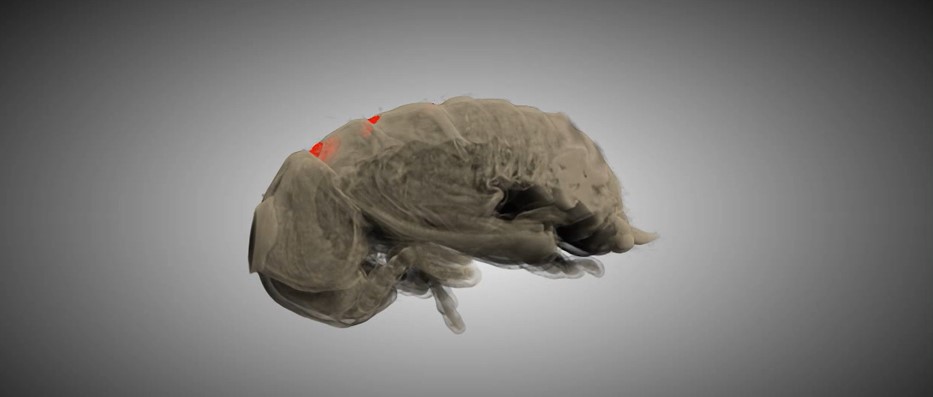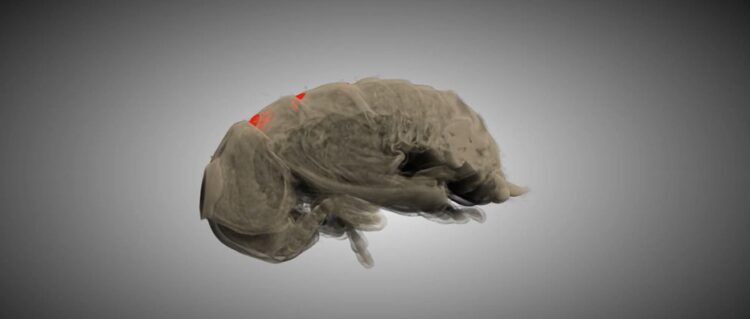Beetles of the genus Lagria need a little help from their bacterial friends throughout their immature life stages. But keeping them in the same spot throughout life isn’t feasible. This is because beetles are holometabolous insects, which undergo an overall bodily reorganization (metamorphosis) as pupae.

Credit: LV Flórez, RS Janke, S Moog, B Weiss, M Kaltenpoth
Beetles of the genus Lagria need a little help from their bacterial friends throughout their immature life stages. But keeping them in the same spot throughout life isn’t feasible. This is because beetles are holometabolous insects, which undergo an overall bodily reorganization (metamorphosis) as pupae.
Here, scientists show for the first time that the beetles have evolved an ingenious solution to this problem: female pupae keep their symbiotic bacteria in specialized pockets on their back. When they emerge as adults, they shuffle the bacteria out of these pockets, backwards and then on into their genital area.
“Here we show how an insect can maintain beneficial microbial partners despite the drastic rearrangements of body structures that occur during metamorphosis,” said corresponding author Dr Laura V Flórez, a researcher at the Department of Plant and Environmental Sciences of the University of Copenhagen. “By modifying unique ‘pockets’ on their backs, Lagria beetles manage to keep their protective symbionts and facilitate their relocation during pupation to newly developed adult organs.”
Unique ‘back pockets’
Females of many Lagria species carry a mix of beneficial bacteria in their accessory glands, a pair of glands next to the oviduct. When females lay eggs, the bacteria are ‘squeezed’ out of the glands and deposited onto the eggs’ surface. Antibiotics produced by the bacteria protect, eggs, larvae, and pupae of the beetles against fungi. In one of the species studied here, L. villosa, the largest component of the symbiotic mix is a strain of Burkholderia bacteria called Lv-StB, which has lost the genes and cellular structures for motility, and likely can’t survive for long outside the beetles.
Flórez and colleagues show that in L. villosa and L. hirta female pupae, the symbionts mostly live inside the three two-lobed pockets on the back of the thorax, where they may be nourished by the beetles. Such ‘back pockets’ in larvae and pupae aren’t known in any other insect. In female pupae, symbionts also congregate in a fourth spot, between bristles at the back of the head. The pockets are only vestigial in male pupae, and contain few or no symbionts. In adult females, the symbionts exclusively live inside the accessory glands, which are absent in males.
‘Long and winding road’
“The symbionts go from the highly exposed egg surface to colonize the pockets on the back of the larvae and pupae. Finally, they end up in specialized glands associated with the reproductive system of adult females,” summarized first author Rebekka S Janke, a doctoral student at the Johannes Gutenberg University of Mainz.
But how do the bacteria colonize the accessory glands after pupation? To answer this question, the authors scattered approximately 1m polystyrene fluorescent beads, 1.0 μm wide, across early pupae. They then show that after emergence, the majority of these beads ended up on the tip of the abdomen. The authors conclude that the beads, like presumably the symbionts, are shuffled towards the genitals by friction during the emergence process. The mechanism by which the symbionts then colonize the accessory glands of females is not yet known.
“In the adult stage, the main purpose of the symbiotic organs seems to be to enable successful transmission onto the egg stage and to the next generation. Since only females lay eggs, male adults do not need to carry these potentially costly symbionts and are a dead-end for the bacteria,” said Flórez.
Coauthor Dr Martin Kaltenpoth, a professor at the Max Planck Institute for Chemical Ecology in Jena, added: “To better understand how beneficial symbionts are transmitted and maintained within and across generations, we’ll need to identify which host and symbiont factors regulate symbiont establishment. For example, does the host select for specific symbionts? And through which mechanisms can immotile symbionts colonize the symbiotic organs?”
Journal
Frontiers in Physiology
DOI
10.3389/fphys.2022.979200
Method of Research
Experimental study
Subject of Research
Animals
Article Title
Morphological adaptation for ectosymbiont maintenance and transmission during metamorphosis in Lagria beetles
Article Publication Date
30-Aug-2022
COI Statement
The authors declare that the research was conducted in the absence of any commercial or financial relationships that could be construed as a potential conflict of interest





